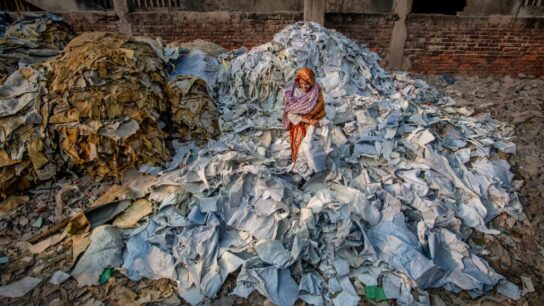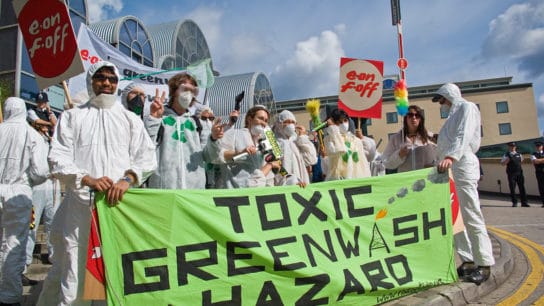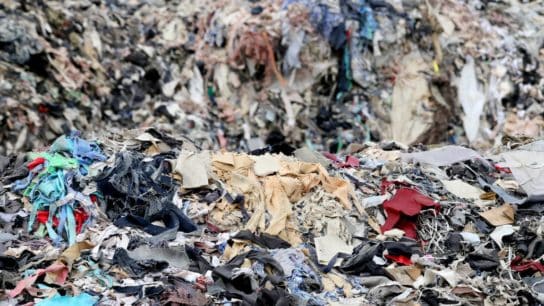Gal-dem investigates how the UK’s voracious consumption of fast fashion and textile waste is threatening Ghana’s second-hand trade, people and environment.
—
According to global campaigning organisation Greenpeace, we buy more clothes per person in the UK than any other country in Europe. Considering the popularity of fast fashion, this is hardly surprising. Less than three weeks since the renewed United Nations Fashion Charter for Climate Action was revealed during the COP26 conference, Black Friday gave a discouraging reminder that some brands still aren’t willing to put the planet and people over profit.
In spite of Pretty Little Thing offering customers up to 99% discount on Black Friday last year, the Boohoo-owned brand went as far as giving a free item with every order on this year’s Black Friday. It’s just one example of the relentless production and consumer appetite for new, cheap styles; the impact of which is being felt in places like Kantamanto in Ghana, home to West Africa’s largest second-hand market and recipient of increasing numbers of poor quality clothing. Today, an estimated 40% of every clothing bale leaves the market as waste, ultimately ending up in landfill or in the sea. This has made it increasingly difficult for market retailers – who are still trying to recoup losses from the pandemic and the market fire last December that put 200 businesses in jeopardy – to make enough profit to sustain their families.
Contrary to what those who donate old clothes with good intentions may think, author of Clothing Poverty, Andrew Brooks, found that only up to 30% of clothes given to the UK’s 10,000 charities are actually bought. The remainder are sold to textile merchants, who sort the clothes into bales by quality and type and then sell them to countries involved in the global second–hand trade. According to Eco-Age, the UK is Ghana’s largest exporter of used-clothes; Canada and the USA come second and third place, respectively.
Kantamanto market, located in the heart of the capital Accra’s central business district, receives approximately 15 million items every week. The trade – known among locals as Obroni W’awu (Dead White Man’s Clothes) – began under British colonial rule and exploded in the 1960s as a for-profit venture and supposedly sustainable solution to the Global North’s excess textile waste. Not only were the clothes sold at the market more affordable than those made by local designers and brands, but they were also of high quality and desirable due to their association with the West.
“Overnight, I lost everything I worked so hard for twelve years to accomplish,” said market retailer Kwaku Mensah.
However, the consequences began to reveal themselves in the 1980s. The trade began to impact the nascent textile and fashion industry to a “degree that it couldn’t really bounce back to its original state,” according to Liz Ricketts, co-founder and director of The OR Foundation, a non-profit organisation that works in solidarity with the Kantamanto community. “You can grow up in Ghana never spending more than 75p on an item of clothing from the second hand market, so it’s impossible for local textile factories, designers and self-employed tailors to compete,” Liz adds.
For fashion designer Samuel Oteng, who also works for The OR Foundation as a community design lab manager, the biggest threat of the colonial gaze is the loss of cultural traditions, such as having your clothes tailor-made. “In Ghana and across Africa, clothes have sentimental value, are made to last and be handed down generations, all of which really set us apart from the Global North, ” he explains. “I worry that the influx of fast-fashion will cause future generations to view clothes as disposable commodities.”

You might also like: 7 Fast Fashion Companies Responsible for Environmental Pollution
The economic and environmental implications of the trade are also alarming. In August 2019, Accra’s Kpone landfill, which is approximately a 1 hour 15 minute drive from Kantamanto market, reached over 30 meters in height and caught on fire. More than five hundred waste pickers, who make a living from recovering valuable resources like plastics and metal, inhaled toxic smoke for several weeks. Then, in December 2020, a section of Kantamanto market was intentionally set on fire by real estate developers seeking valuable land, according to an investigation by The OR Foundation. The fire affected over 200 businesses, destroying 856 clothing bales and at least 190 sewing machines. In total, The OR Foundation reported that the community suffered more than £187,000 in losses during what was supposed to be its peak season.
“Overnight, I lost everything I worked so hard for twelve years to accomplish. Every day, I wake up and go to bed with the same worries about how I’m going to manage to support my family,” says retailer Kwaku Mensah, who has worked at the market for twelve years. Another retailer, John Opuku Agyemang, had no choice but to move his three children to cheaper schools. “When the fire happened, I felt like I lost a part of myself,” he says.
Almost a year has passed, but the perpetrators still haven’t been punished. Due to the lack of government support to build a safe electrical system, the community has had to improve and connect their sewing machines to very distant sources. A single fault could cause a major power surge, putting them at imminent risk of another fire. On 29 January, The OR Foundation launched a campaign to provide immediate crisis relief. By the end of March, the Fire Relief Fund reached over £18,000 – it was split between 192 people, with £750 saved for a rainy season. Now, the foundation’s target is to raise at least £187,000 by Black Friday 2022 through its Secondhand Solidarity Fund. The money will go directly towards supporting individuals and the wider community through crisis and debt relief, healthcare and market reconstruction.
Afternoon in the market. Photo by: Nana Kwadwo Agyei Addo courtesy The OR Foundation.
Kantamanto is the largest reuse and upcycling hub in the world, recirculating 100 million garments every four months, yet it hasn’t received any investment from major players, brands, charities, collectors or exporters. To put this into context, the world’s largest fashion resale platform ThredUp receives millions of dollars, but it takes ten years to recirculate the same amount of items.
“We don’t need more clothes – we need quality and for brands to take accountability for their waste,” says retailer John. As the local government does not have the capacity to pick up all of the textile waste from the market, some of it is being dumped into the sea. It is common for long tentacles of clothing to catch onto boat motors, which puts fishermen at risk of capsizing. With less than 20% of market retailers making a net profit on the average clothing bale, the Kantamanto community is stuck in a debt cycle and the city is having to spend thousands of dollars a year to collect and landfill a portion of the textile waste at the expense of its healthcare and education systems.
“Ghana makes the problem of waste visible because it doesn’t have the luxury of the Global North to divert and hide it,” said Liz Ricketts, co-founder of the OR Foundation.
It is undeniable that the global second-hand trade is having severe financial and environmental consequences for the Kantamanto community and Ghana more broadly. Nevertheless, it is imperative for the market to continue to function because it supports the livelihoods of 30,000 people and makes purchasing clothing affordable for the country’s poorest citizens.
The foundation is working directly with the community at their Art Design Lab to transform textile waste into new products such as fibre boards. But grassroots initiatives like this cannot fix the problem on their own. In addition to receiving donations for urgent crisis relief, the foundation is asking for countries in the Global North to reduce the production of new clothing by at least 80%, and to invest in the resale, repair and upcycling of the surplus textile waste as well as the infrastructure required to build a local circular economy in Kantamanto. As Liz says, “Ghana makes the problem of waste visible because it doesn’t have the luxury of the Global North to divert and hide it.”
To support the OR Foundation and their work with the community in Kantamanto, find out more and donate here.
This story originally appeared in gal-dem, written by Dayna Tohidi, and is republished here as part of Covering Climate Now, a global media collaboration strengthening coverage of the climate story.


















